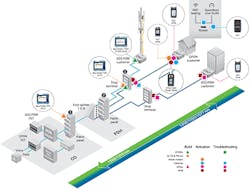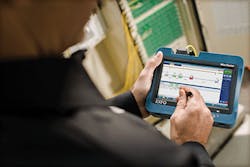Latest from 5G/6G & Fixed Wireless Access/Mobile Evolution
Top Network Assurance Priorities For Service Providers In 2022
As the world moves towards a new normal in the wake of the global COVID-19 pandemic, communications service providers are focused on the next set of challenges and opportunities on the horizon.
The pace of network transformation has not slowed; it has, like bandwidth demand, accelerated significantly. With the availability of sophisticated solutions for everything from business and personal collaboration to the Internet of Things (IoT) and gaming/entertainment, there is amped-up demand for high-speed, reliable services for enterprises and end-users.
The motto associated with the long-running American television show Survivor is, Outwit. Outplay. Outlast. Perhaps for service providers, the mantra for 2022 is Adopt. Adapt. Accelerate. as they tackle the following top priorities for 2022.
Adopt
Global 5G connections are growing rapidly — reported as up 41% from Q1 to Q2 2021 according to 5G Americas based on data from Omdia. In the second quarter of 2021, global wireless 5G connections reached 429 million, the data from Omdia reveals. It seems the rapid pace of 5G adoption globally shows no signs of slowing as service providers move to the next generation of mobile technology.
What may be overlooked, however, is the necessity for a reliable, ubiquitous, and always-on, optical fiber infrastructure to support 5G rollouts with 5G fiberization. Fiber everywhere will be key to successful 5G deployment, and service providers will be extending the fiber reach of their networks to connect seamlessly and reliably from the core to the edge of the network.
Paramount to providing that secure infrastructure will be testing — testing at every stage from design to construction, and turn-up/troubleshooting to long-term monitoring. This is essential to ensure that all connection points are secure and that network spans are deployed first-time-right to minimize OpEx and truck-rolls. Mission-critical mobile communications will rely heavily on fiber infrastructure to be available and reliable 24/7, with issues flagged and mitigated before they become service-affecting.
A key focus for service providers during 2022 will be ensuring best Quality of Service (QoS) based on a high-performance fiber infrastructure supporting 5G networking.
Adapt
An important part of the fiber everywhere mindset resides in the access network, the fiber-to-the-premises (FTTP) or fiber-to-the-home (FTTH) scenario, to ensure ultra-fast broadband connectivity to homes and multi-dwelling units (MDUs). Similar to FTTH initiatives, a fiber-deep strategy pushes the optical-to-electrical conversion closer to subscribers, which increases potential bandwidth to homes and cuts power and maintenance costs.
The global COVID-19 pandemic shone a spotlight on the critical role of FTTH for working, learning, and socializing; consumers and businesses will continue to expect access to high-speed symmetric broadband in 2022. (See Figure 1.) That translates into testing at every step of the deployment process — not relying solely on manufacturers’ pre-testing of equipment. This can prevent a "plug-and-pray" scenario which can have disastrous results. Field automated testing solutions can help service provider workforce technicians become test experts in no time, avoiding the unnecessary repairs and repeat truck rolls that add expense and delays.
Figure 1. Fiber-to-everywhere network architecture.
Service providers will continue to prioritize FTTH throughout 2022 to deliver services to end-user customers, especially given the numerous broadband stimulus packages being offered by governments globally. And adopting the latest test technologies helps ensure optimum performance.
A perfect example of this need for adaptation can be found in data centers. The Internet of Things (IoT) or machine-to-machine connectivity is becoming the dominant form of communication as sophisticated servers share traffic, and networks support connected devices. While humans are tolerant of network outages and degradations, machines are not because of their inherent mission-critical functionality and performance subject to signal loss and latency. According to the GSMA’s 2020 report The Mobile Economy, IoT connections will reach almost 25 billion globally by 2025, up from 12 billion in 2019.
The exponential growth in data traffic and demand for cloud services and virtualization is driving data center transformation, with operators moving from copper to fiber and 10 Gbps to 100/400 Gbps. And data centers are proliferating at the edge of the network to better support broadband and wireless communications in core metro networks.
Hyperscalers continue to build data centers closer to the network edge, heating up the competition for low-latency services. This puts pressure on service providers to ensure that data centers are ready for the onslaught of mission-critical traffic traversing the network and converging at the data center.
Growth in interconnect bandwidth is happening even within the confines of data centers, necessitating reliable infrastructure with low latency and packet loss. As service providers transform their data centers, test solutions that can certify fiber, perform validation testing for Ethernet, and Optical Transport Networking (OTN), plus test solutions for quick and efficient connector testing, are important to ensure QoS. This is another key area of focus for service providers in 2022.
Accelerate
This year, service providers continue to be focused on delivering services faster with high quality while striving to be cost-effective. High-speed networking of 400 to 800 Gbps is a reality, and service providers will invest more and more in ultra-high-speed transmission.
Getting more data down the pipe faster to serve more customers and to deliver a more extensive suite of services is the name of the competitive game. Clearly, service providers will be placing major emphasis on cost-effectively achieving high-speed networking while maintaining QoS.
Successful high-speed deployment depends on accurate fiber characterization and troubleshooting in the end-to-end network. Industry advances in Optical Time Domain Reflectometer (OTDR) technology have automated field testing during the construction phase, providing greater accuracy and efficiency. EXFO’s intelligent Optical Link Mapper (iOLM) takes OTDR testing a step further using multi-pulse acquisitions and advanced algorithms to deliver information on every element in a fiber link. (See Figure 2.)
Best Principles For 2022
This year, service providers are accelerating bandwidth with new deployments and high-speed networking, using advanced test technology to ensure QoS. That means they must embrace 4 key best practices as they move forward:
- Adopt automated processes to ensure that they succeed with first-time-right deployments.
- Pay attention to outsourced deployments. While field testing solutions can help technicians be more proficient, service providers who are outsourcing more network builds and hiring more contractors may feel they lack oversight to ensure that deployments are being done according to their standards. Remote, cloud-based solutions can provide that needed visibility for live key performance indicator (KPI) reporting and business intelligence (BI) dashboards.
- Consider remote network monitoring that delivers end-to-end visibility of the network and identify bottlenecks or issues before they can cause outages.
- Automating processes and taking advantage of advanced test tools are imperative for service providers to scale operations and expand their network reach and capabilities, and this is a top area of focus in 2022.
Emerging from challenging times, service providers are now stepping up to expansive opportunities. It’s time for service providers to Adopt, Adapt, and Accelerate. to meet their targets by focusing on key priorities and leveraging the latest test technology to succeed.
Resources And Notes
https://www.globenewswire.com/news-release/2021/09/22/2301608/0/en/Global-5G-Connections-Are-Growing-Rapidly.html
https://www.gsma.com/mobileeconomy/wp-content/uploads/2020/03/GSMA_MobileEconomy2020_Global.pdf
For more information, please email [email protected] or visit www.exfo.com/en/solutions/communication-service-providers/. You can also follow us on Twitter @EXFO. Our social media handle is @exfo. Follow Stephane Chabot on LinkedIn: https://www.linkedin.com/in/stephanechabot/.







